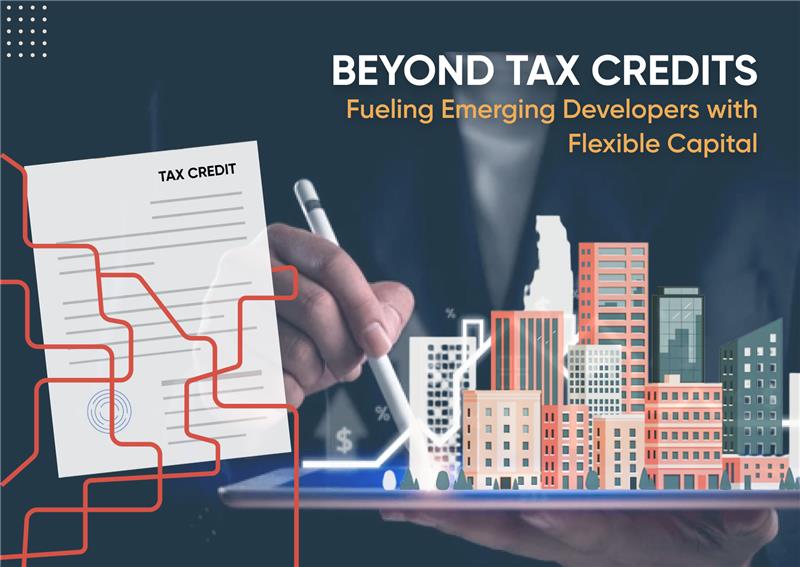Tax credits are investments in affordable housing, not emerging real estate developers. The industry needs to recognize the difference.
For years, programs like the Low-Income Housing Tax Credit (LIHTC), New Markets Tax Credit (NMTC), and Historic Tax Credits (HTC) have been touted as essential resources for real estate projects that serve public good. And they are. But let’s be clear: tax credits are not the same as upfront capital, and for emerging developers——they often fall short of what’s needed to bring a project to life or help a company grow. The reason this matters is that if smaller developers do not have viable pathways to scaling their operations, they will never pursue the larger, more catalytic projects required to truly address America’s housing crisis or unlock the economic potential embedded in its inner cities.
The Disconnect
Emerging developers are frequently encouraged to pursue tax credit deals because the credits limit the amount of equity they must either directly contribute or raise from third party investors. But such recommendations often minimize the amount of time, effort, and capital required to bring such deals to fruition. The eligibility guidelines and structures of tax credit programs are often maze-like and byzantine. Applications are voluminous and subject to strict scrutiny. And awards can take 18-36 months to obtain if they materialize.
Even once they have been awarded, coordinating between tax syndicators, senior lenders, and public and private sources of subsidies can be daunting and dizzying.
And like all developments, these projects still also incur upfront costs associated with obtaining site control, preparing feasibility studies, architectural designs, legal opinions and diligence, environmental testing while also requiring regular community engagement—all costs incurred long before a shovel hits the ground.
For developers without access to local subsidies or flexible pre-development funding, these aren’t just challenges. They’re dealbreakers.
Supporting Data
- According to Grounded Solutions Network, average predevelopment costs for affordable housing can range from $25,000 to $50,000 per unit, depending on project complexity and location.
- A Brookings study found that more than 65% of Black real estate developers surveyed abandoned or delayed projects due to lack of access to equity or bridge financing.
- The Initiative for a Competitive Inner City (ICIC) reports that only 16% of Black and Latinx developers have regular access to institutional capital, compared to 49% of their white peers.
- In high-cost urban markets, some projects require $500K to $1M in predevelopment capital before equity investors or tax credit syndicators even enter the picture.
In other words, tax credits are an important piece of the puzzle—but not a replacement for operational capital.
Who Gets Left Behind
Large, well-capitalized firms have entire departments dedicated to structuring deals and floating predevelopment costs across multiple projects. Emerging developers don’t. When capital markets are tight or risk appetite shrinks, these firms lose access first.
Even if a developer is awarded tax credits, they often struggle to bridge gaps in the capital stack or provide loan guarantees with sufficient net worth and liquidity to satisfy lenders. This creates a self-fulfilling cycle where only a narrow set of players ever get to scale (My firm, Diversified Lending Solutions, addresses this problem by connecting developers with high-net worth JV partners to satisfy these requirements).
Potential Solutions: What Emerging Developers Really Need
To truly support the next generation of real estate leaders, we need more than credits. We need capital that reflects trust, flexibility, and timing.
Here are four capital tools that should be on the table:
- Programmatic Equity: Long-term capital commitments that span multiple projects—not just one-off investments—enable developers to plan, hire, and grow with confidence.
- Lines of Credit for Multi-Use Deployment: Credit lines that can be used across predevelopment, deposits, acquisition, or working capital reduce the need to apply for new loans every time a deal arises. These can be secured against portfolio equity.
- Recoverable Grants or Zero-Interest Loans: Especially valuable for technical assistance, early design work, and feasibility studies—critical first steps that often go unfunded. These are repaid only if the project closes.
- Predevelopment and Acquisition Loans with Flexible Terms: Standard terms often don’t reflect the realities of early-stage or mission-driven projects. Loan products should align repayment with project milestones and allow for deferred payments, accrued interest, and extensions without penalties.
A New Capital Stack Requires a New Mindset
If we’re serious about expanding the developer ecosystem, a critical piece of addressing some of America’s most serious economic and social problems, we have to stop acting like the presence of a tax credit award equals access to capital. Institutional investors and public agencies must go further—designing deal structures that account for the financial realities facing small and diverse developers.
Tax credits can be catalytic. But they work best when paired with flexible, patient capital that meets developers where they are—not just where we say where they should be.



